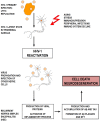The Infectious Etiology of Alzheimer's Disease
- PMID: 28294067
- PMCID: PMC5652018
- DOI: 10.2174/1570159X15666170313122937
The Infectious Etiology of Alzheimer's Disease
Abstract
Background: Inflammation is a part of the first line of defense of the body against invasive pathogens, and plays a crucial role in tissue regeneration and repair. A proper inflammatory response ensures the suitable resolution of inflammation and elimination of harmful stimuli, but when the inflammatory reactions are inappropriate it can lead to damage of the surrounding normal cells. The relationship between infections and Alzheimer's Disease (AD) etiology, especially lateonset AD (LOAD) has been continuously debated over the past three decades.
Methods: This review discusses whether infections could be a causative factor that promotes the progression of AD and summarizes recent investigations associating infectious agents and chronic inflammation with AD. Preventive and therapeutic approaches to AD in the context of an infectious etiology of the disease are also discussed.
Results: Emerging evidence supports the hypothesis of the role of neurotropic viruses from the Herpesviridae family, especially Human herpesvirus 1 (HHV-1), Cytomegalovirus (CMV), and Human herpesvirus 2 (HHV-2), in AD neuropathology. Recent investigations also indicate the association between Hepatitis C virus (HCV) infection and dementia. Among bacteria special attention is focused on spirochetes family and on periodontal pathogens such as Porphyromonas gingivalis or Treponema denticola that could cause chronic periodontitis and possibly contribute to the clinical onset of AD.
Conclusion: Chronic viral, bacterial and fungal infections might be causative factors for the inflammatory pathway in AD.
Keywords: Alzheimer’s Disease; chronic bacterial infections; chronic viral infections; neuroinfection; neuroinflammation; neurotropic viruses..
Copyright© Bentham Science Publishers; For any queries, please email at epub@benthamscience.org.
Figures
References
-
- Alzheimer’s Association Alzheimer’s Disease facts and figures. Alzheimers Dement. 2015;11(3):332. - PubMed
-
- Kumar A., Singh A., Ekavali N. A review on Alzheimer’s disease pathophysiology and its management: an update. Pharmacol. Rep. 2015;67(2):195–203. [http://dx.doi.org/10.1016/j.pharep.2014. 09.004]. [PMID: 25712639]. - PubMed
-
- Mawanda F., Wallace R. Can infections cause Alzheimer’s disease? Epidemiol. Rev. 2013;35:161–180. [http://dx.doi.org/ 10.1093/epirev/mxs007]. [PMID: 23349428]. - PMC - PubMed
-
- Bourgade K., Le Page A., Bocti C., Witkowski J.M., Dupuis G., Frost E.H., Fülöp T., Jr Protective effect of amyloid-β peptides against herpes simplex virus-1 infection in a neuronal cell culture model. J. Alzheimers Dis. 2016;50(4):1227–1241. [http://dx.doi. org/10.3233/JAD-150652]. [PMID: 26836158]. - PubMed
-
- White M.R., Kandel R., Tripathi S., Condon D., Qi L., Taubenberger J., Hartshorn K.L. Alzheimer’s associated β-amyloid protein inhibits influenza A virus and modulates viral interactions with phagocytes. PLoS One. 2014;9(7):e101364. [http://dx.doi.org/10.1371/journal.pone.0101364]. [PMID: 24988208]. - PMC - PubMed
Publication types
MeSH terms
LinkOut - more resources
Full Text Sources
Other Literature Sources
Medical
Miscellaneous


